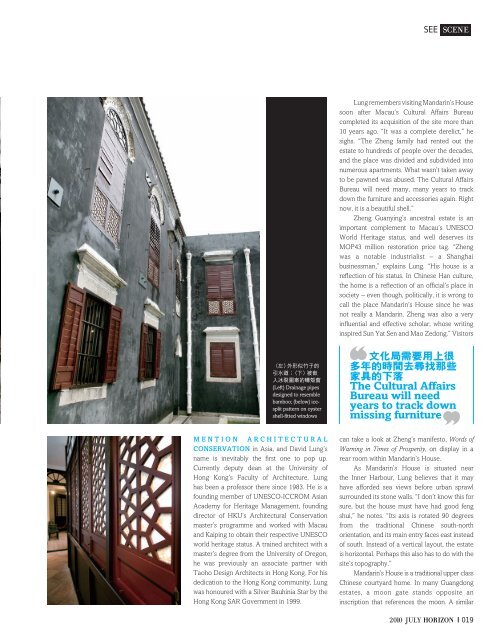july-2010
july-2010
july-2010
You also want an ePaper? Increase the reach of your titles
YUMPU automatically turns print PDFs into web optimized ePapers that Google loves.
(左)外形似竹子的<br />
引水道;(下)被嵌<br />
入冰裂圖案的蠔殼窗<br />
(Left) Drainage pipes<br />
designed to resemble<br />
bamboo; (below) icesplit<br />
pattern on oyster<br />
shell-fitted windows<br />
Mention architectural<br />
conservation in Asia, and David Lung’s<br />
name is inevitably the first one to pop up.<br />
Currently deputy dean at the University of<br />
Hong Kong’s Faculty of Architecture, Lung<br />
has been a professor there since 1983. He is a<br />
founding member of UNESCO-ICCROM Asian<br />
Academy for Heritage Management, founding<br />
director of HKU’s Architectural Conservation<br />
master’s programme and worked with Macau<br />
and Kaiping to obtain their respective UNESCO<br />
world heritage status. A trained architect with a<br />
master’s degree from the University of Oregon,<br />
he was previously an associate partner with<br />
Taoho Design Architects in Hong Kong. For his<br />
dedication to the Hong Kong community, Lung<br />
was honoured with a Silver Bauhinia Star by the<br />
Hong Kong SAR Government in 1999.<br />
see Scene<br />
Lung remembers visiting Mandarin’s House<br />
soon after Macau’s Cultural Affairs Bureau<br />
completed its acquisition of the site more than<br />
10 years ago. “It was a complete derelict,” he<br />
sighs. “The Zheng family had rented out the<br />
estate to hundreds of people over the decades,<br />
and the place was divided and subdivided into<br />
numerous apartments. What wasn’t taken away<br />
to be pawned was abused. The Cultural Affairs<br />
Bureau will need many, many years to track<br />
down the furniture and accessories again. Right<br />
now, it is a beautiful shell.”<br />
Zheng Guanying’s ancestral estate is an<br />
important complement to Macau’s UNESCO<br />
World Heritage status, and well deserves its<br />
MOP43 million restoration price tag. “Zheng<br />
was a notable industrialist – a Shanghai<br />
businessman,” explains Lung. “His house is a<br />
reflection of his status. In Chinese Han culture,<br />
the home is a reflection of an official’s place in<br />
society – even though, politically, it is wrong to<br />
call the place Mandarin’s House since he was<br />
not really a Mandarin. Zheng was also a very<br />
influential and effective scholar, whose writing<br />
inspired Sun Yat Sen and Mao Zedong.” Visitors<br />
文化局需要用上很<br />
多年的時間去尋找那些<br />
家具的下落<br />
The Cultural Affairs<br />
Bureau will need<br />
years to track down<br />
missing furniture<br />
can take a look at Zheng’s manifesto, Words of<br />
Warning in Times of Prosperity, on display in a<br />
rear room within Mandarin’s House.<br />
As Mandarin’s House is situated near<br />
the Inner Harbour, Lung believes that it may<br />
have afforded sea views before urban sprawl<br />
surrounded its stone walls. “I don’t know this for<br />
sure, but the house must have had good feng<br />
shui,” he notes. “Its axis is rotated 90 degrees<br />
from the traditional Chinese south-north<br />
orientation, and its main entry faces east instead<br />
of south. Instead of a vertical layout, the estate<br />
is horizontal. Perhaps this also has to do with the<br />
site’s topography.”<br />
Mandarin’s House is a traditional upper class<br />
Chinese courtyard home. In many Guangdong<br />
estates, a moon gate stands opposite an<br />
inscription that references the moon. A similar<br />
<strong>2010</strong> JUlY Horizon 019


